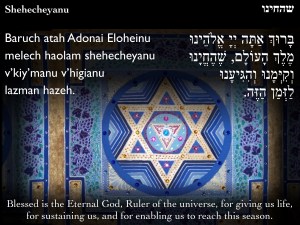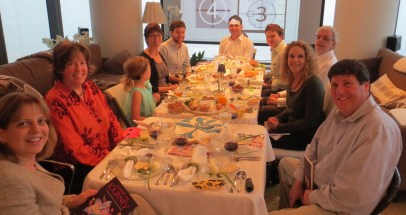
It was Friday morning, the day after Yom Kippur. Even though we were exclusively worshiping on Zoom throughout the High Holy Days, I felt a sense of peace and contentment, and a strong connection to the Temple Sholom family. All of our services were held using Visual T’filah. Without machzorim in hand, we were able to truly pray as a community with our electronic devices. I was very tired after all the preparation leading up to the Holy Days and after leading so many different types of services, but Shabbat comes every week, ready or not. I could have reused a previous Visual T’filah Shabbat service I had put together, but I had a strong desire to create a new service. And then it dawned on me that crafting a Visual T’filah service is a form of praying for me, in and of itself.
I start with a set of Mishkan T’filah Visual T’filah slides from CCAR Press, which have all the prayers from the prayer book. I focus on the service as a whole and explore the feeling I want the day’s prayers to convey. What is going on in the world around us? What inspiration can I glean from the Torah portion? Should the service be upbeat and celebratory, or more contemplative and calming? What do we, as a community, need this particular Shabbat?
Next, I focus on one prayer at a time. What is this particular prayer saying to me today? I look through my collection of photographs and art to find the image that best portrays that feeling. I also search through my collection of music to find just the right melody to enhance the feeling of the prayer as it speaks to me. As I work on each prayer slide, finding the best way to arrange the text around the picture, the words of the prayer permeate my soul. I am praying as I create each slide.
For example, the Mi Chamochah has many different melodies. Many of them are joyous. Others are more contemplative. The celebratory melodies reflect the excitement of the Israelites finally making it to the other shore and rejoicing in their newfound freedom. I see the more contemplative melodies reflecting amazement and awe. “Wow. Did we really make it? Are we really safe now?” I choose a particular melody based on the emotion the congregation might most benefit from that Shabbat.

Then I attach a visual. I often use visuals containing water for Mi Chamochah. It doesn’t have to be the Red Sea; it can be a river or an ocean. The visual helps me—and the congregation—feel as if we were there with the Israelites on their journey. As I put each prayer slide together, playing the music to make sure it goes with the visual, I find myself praying the Mi Chamochah as I compose the slides. I feel completely immersed in the message of the prayer and experience connection to God through those words.
Some of the images I use are photos. Others are graphics. Sometimes I choose more abstract images to allow for each person’s imagination to explore the words of the reading or prayer.

Shabbat is about creation. In the Kiddush we read, Zikaron l’maaseih v’reishit —“A reminder of the work of Creation.” Made in the image of God, each Shabbat I create a prayer world, for myself, and for the congregation.
Rabbi Michele B. Medwin, DMin serves Temple Sholom in Monticello, New York. Her Mi Shebeirach Prayer for Chronic Illness appears in Mishkan R’fuah: Where Healing Resides, published by CCAR Press.




 During the second and third year’s planning meetings, I fretted that many of those booklets had not returned to us. I was concerned about the potential chilul of where those booklets might have ended up and about the environmental waste of resources that would not be re-used and possibly not recycled. I wanted to revise some of the language we had chosen, but didn’t want to get rid of all the books we still had on hand. Some time between the third and fifth year I encountered
During the second and third year’s planning meetings, I fretted that many of those booklets had not returned to us. I was concerned about the potential chilul of where those booklets might have ended up and about the environmental waste of resources that would not be re-used and possibly not recycled. I wanted to revise some of the language we had chosen, but didn’t want to get rid of all the books we still had on hand. Some time between the third and fifth year I encountered 





 ne amazing work so far. However, the finite amount of time she is able to dedicate to creating the Visual T’filah each week, given her other responsibilities around camp, meant that her scope was limited. Now with the introduction of the CCAR Visual T’filah Template (which includes the text of
ne amazing work so far. However, the finite amount of time she is able to dedicate to creating the Visual T’filah each week, given her other responsibilities around camp, meant that her scope was limited. Now with the introduction of the CCAR Visual T’filah Template (which includes the text of 











